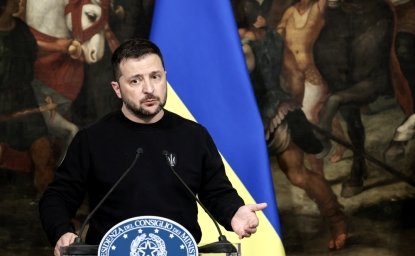
A blog of the Kennan Institute
After the Euromaidan, decentralization, whereby certain authorities were devolved to local and regional administrative bodies, became one of the most successful reforms in Ukraine. Decentralization has strengthened the ability of local governments to respond to the needs of their communities and manage local resources, especially tax revenues.
Since the introduction of martial law in 2022, however, Kyiv has significantly limited the powers of local governments. The means for doing so are contained in a decree President Zelensky signed urgently on the first morning of the invasion converting civil administrations in the regions to military ones. This change was subsequently fleshed out with the addition of military personnel to regional administrative bodies. The effect was to create a military-inflected chain of control across Ukraine that reaches down to the local levels of governance, where it meets resistance to some stipulations.
For defense purposes—to fund the war—the government and its military-civil administrations have been increasing pressure on local self-governance structures, particularly by rejiggering tax flows to Kyiv. This has resulted in a growing gap between central and local governments in wartime Ukraine and disagreement between local self-governing authorities and the military authorities higher up the chain. In some cases the new arrangement has allowed antagonists to discharge old personal disputes or jockey for political space.
Declining Trust in Government
Public opinion surveys underscore the growing gap between central and local governments. In the fall, for the first time since the beginning of Russia’s full-scale aggression in Ukraine, sociologists recorded a decline in Ukrainians' confidence in the actions of the president and government. By contrast, the level of trust in local authorities has remained stable, at 50 percent, over the past two years. This indicates that citizens perceive local governments as performing their functions effectively enough and meeting citizens’ needs.
Local authorities also actively support the military and civilians affected by the war. They have used their resources to accommodate internally displaced persons, treat wounded fighters, and ensure the security of the rear and the operations of businesses that had to relocate.
Nonetheless, it seems that the central government does not currently see local self-government as a reliable partner. Since the beginning of martial law, the state authorities have legislated a number of restrictions on the powers of local authorities to ensure defense and the relevant security regime. But some of these restrictions did not comply with the law. For example, the government issued a decree depriving of their budgetary powers not only the regional and district councils that were under occupation or in a war zone but also all other councils at these levels in the territories that are in the rear. Regional and district budgets across Ukraine are increasingly managed by local state-level bodies rather than by local councils.
Tensions also ratcheted up when the central government took away some tax revenues from the local communities that had previously been paid into community budgets in the form of personal income taxes. A significant part of the local tax revenue comes from the income taxes paid by military personnel, and it is these funds that Kyiv has decided are to be paid directly to the central state budget starting in November 2023 and continuing until the end of martial law. Kyiv says these funds are to be used for the army’s needs, but their loss means curtailing the amount communities allocate to supporting the forces locally.
Despite the pro-presidential, one-party majority in the Rada, this redistributive decision was approved only with difficulty. It took three attempts to be passed by parliament. MPs, especially those elected in majority districts, understood how unpopular the measure was at home.
The central government provides some compensation out of the central state budget to communities affected by this decision. In conversations with me, however, some local leaders expressed doubt as to the ability of the central budget to fulfill the plan for revenue allotment. Accordingly, local communities cannot count on being able to address their basic needs or to devote part of their budget to helping local units of the Armed Forces of Ukraine, as has been the usual practice since 2022. Kyiv mayor Vitaly Klichko has been quite vocal in pointing out the problems with the measure, raising the possibility it might weaken rather than strengthen the nation’s defenses.
Unhappiness is growing not only locally but also in the regions. Regional military-civil administrations redistribute local budgets in accordance with their own plans. This creates many misunderstandings between them and local communities. The administrations cut spending on road reconstruction, sports events, and the like; one example here is the now withdrawn tender for reconstruction of the Novoyarivsk biathlon shooting range and skating rink, which was deemed an inefficient use of funds while the country is at war.
Drones Instead of Stadiums
The central government parsed its decision as “drones instead of stadiums,” meaning that the budget must be directed toward defense, not toward most civilian projects. It also hints at a belief on the part of the central government that local councils are spending their money not only on unnecessary goals but also for corruption. In response, local leaders say that they don‘t want to pay for "a military tax to those who buy eggs for 17 UAH and spend millions on a telethon."
I believe that the solution to the current state of affairs lies in joint planning of expenditures from tax revenues, transparency in how funds are distributed, and clear rules around this matter. However, the local communities should be able to retain some of the monies scheduled to be directed to Kyiv local communities. Some method of balancing the needs and authorities of central and local administrations must be put in place, especially if the war turns into a war of attrition. If the central government is able to handle defense needs, local governments can focus on taking care of the rest of the population’s needs.
The growing tensions between the central and local governments during the war only amplify governance issues and limit trust among citizens, who continually hear each side accuse the other of corruption. It’s true that some of these accusations are not groundless, especially in cases where civil and local community control is impossible, and in such cases the anti-corruption organizations should investigate. However, the level of corruption is many times lower than what the accusations might suggest, and politicization of this issue harms the political order. And a stable central government is critically important for Ukrainians’ common aim—victory.
The opinions expressed in this article are those solely of the author and do not reflect the views of the Kennan Institute
Author


Kennan Institute
The Kennan Institute is the premier US center for advanced research on Eurasia and the oldest and largest regional program at the Woodrow Wilson International Center for Scholars. The Kennan Institute is committed to improving American understanding of Russia, Ukraine, Central Asia, the South Caucasus, and the surrounding region though research and exchange. Read more

Explore More in Focus Ukraine
Browse Focus Ukraine
Building a Thriving Ukrainian Design Community Now

Ukraine Seeks to End the War. What's Wrong With the “Peace Scenarios”?


